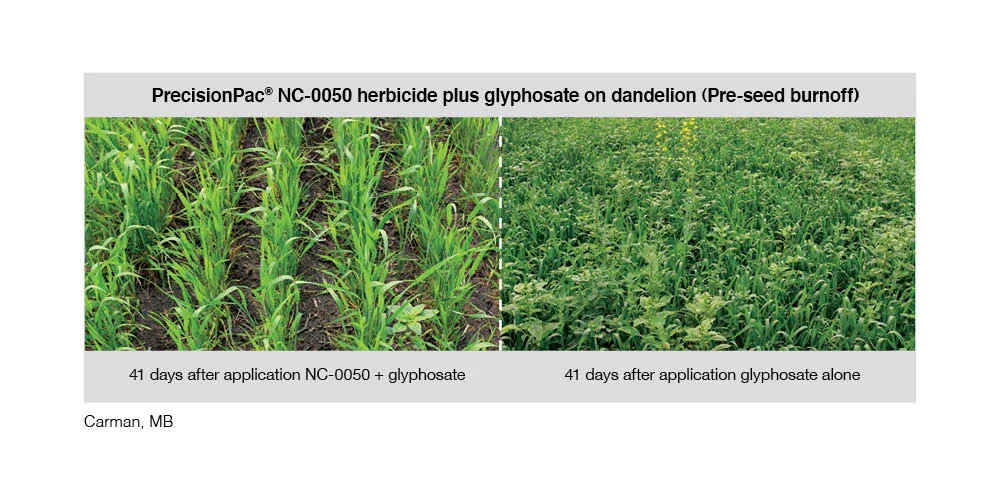Quick Facts
-
Hard hitting burnoff weed control
-
Maximum flexibility
-
Systemic activity gets to the root of toughest weed problems
-
Customized package size to fit your sprayer tank or field size
Supporting Documents
Jump to
Product Overview
NC-0050’s systemic activity gets right to the root of your toughest weed problems, yet it leaves you with maximum cropping flexibility so you can seed a wide variety of crops 24 hours after application. As a PrecisionPac® herbicide, you also get the flexibility to customize your package size to fit your sprayer tank or field size.

Crops
Spring Wheat
Winter Wheat
Durum Wheat
Barley
Oats
*Note: injury may occur on coarse-textured soils, low in organic matter (less than 3%) or in fields with variable soils, gravely areas, sandy areas or eroded knolls. Avoid planting crops in soils containing more than 50% sand. Heavy rainfall soon after application may result in visual crop injury or possible yield reduction. Conditions such as thin crop stand, sandy soil or low soil organic matter may increase the severity of injury.
Fields treated with a post-harvest application of NC-0050 herbicide in the fall may be seeded in the spring to spring wheat (including durum), spring barley, oats, field corn, canary seed or pulse crops (including chickpea, dry bean, faba bean, field pea, lentil, lupin and soybean), canola, flax, alfalfa, red clover or alsike clover, smooth bromegrass, meadow bromegrass, timothy and creeping red fescue, or fields may be summer fallowed. Canola, field corn, lentils, soybean or white beans after a post harvest application occurring prior to October 1.
Full crop listing
- Spring Wheat
- Winter Wheat
- Durum Wheat
- Barley
- Oats
- Alfalfa*
- Red Clover*
- Alsike Clover* (seed or forage production)
- Smooth Bromegrass*
- Meadow Bromegrass*
- Timothy* and Creeping Red Fescue*
- Canary Seed
- Pulse Crops* (including Dry Bean*, Faba Bean*, Field Pea*, Lupin* and Soybean*)
- Alberta
- Saskatchewan
- Manitoba
Product Specifications
Tech Specs
Chemical Group: 2
Registered and Supported Tank-mix Options:
-
Must be tank mixed with glyphosate
-
Aim® EC herbicide
-
Authority® 480 herbicide (faba bean, field pea, soybean, spring wheat and durum wheat)
-
2,4-D Ester (summer fallow and post harvest)
-
Authority® Supreme herbicide (field peas and soybeans) and Focus® herbicide (spring and winter wheat, soybeans)
Timing:
Pre-seed burnoff in front of:
-
Seed spring wheat, winter wheat, durum, barley, oats, alfalfa*, red clover*, alsike clover* (seed or forage production), smooth bromegrass*, meadow bromegrass*, timothy* and creeping red fescue*, canary seed and pulse crops* (including dry bean*, faba bean*, field pea*, lupin* and soybean*)
*Note: injury may occur on coarse-textured soils, low in organic matter (less than 3%) or in fields with variable soils, gravely areas, sandy areas or eroded knolls. Avoid planting crops in soils containing more than 50% sand. Heavy rainfall soon after application may result in visual crop injury or possible yield reduction. Conditions such as thin crop stand, sandy soil or low soil organic matter may increase the severity of injury.
Chemfallow:
-
Allow at least 10 days after treatment before tillage. Any of the above crops can be seeded 24 hours after application. Two (2) months after application, you can also seed canola, flax.
Fall:
-
Fields treated with a post-harvest application of NC-0050 herbicide in the fall may be seeded in the spring to spring wheat (including durum), spring barley, oats, field corn, canary seed or pulse crops (including chickpea, dry bean, faba bean, field pea, lentil, lupin and soybean), canola, flax, alfalfa, red clover or alsike clover, smooth bromegrass, meadow bromegrass, timothy and creeping red fescue, or fields may be summer fallowed. Canola, field corn, lentils, soybean or white beans after a post-harvest application occurring prior to October 1.
Application Information:
-
Rates: 6.07 g/ac
-
Acres per grower bag: Minimum: 40 acres; Maximum: 320 acres
-
Surfactant: Not required when tank-mixed with a minimum of 0.5 L/ac equivalent of glyphosate.
-
Water Volume: Minimum 5-10 US gal/ac
-
Mixing Instructions: For complete mixing instructions, product guide.
-
Rainfastness: If rain occurs soon after application, control may be reduced. Environmental conditions that slow the drying of the spray mixture on the foliage such as high relative humidity, cool air temperatures or cloud cover, may increase the time required. Refer to the PrecisionPac® NC-0050 herbicide label for complete use instructions.
Rates and Packaging:
-
Rate: 6.07 g/ac
-
Min acres: 40 acres
-
Max acres: 320 acres
-
Customized package size to fit your sprayer tank or field size
Water Volume:
-
Water Volume: Minimum 5-10 US gal/ac
Mixing Instructions:
- Start with a clean empty sprayer. Ensure sprayer is equipped with 50 mesh screens or filters when using FMC products.
- Fill sprayer tank ½ full with clean water in order to ensure enough water for added product to dilute properly
- With agitator running, slowly add the FMC PrecisionPac(R) herbicide products according to their formulation as shown below in the WAMLEGS chart.
- Wettable powders, dispersible granules, soluble granules (WG, DF, SG, WP, SP)
-
Agitate tank mix thoroughly
-
Micro-encapsulated suspensions (ME)
-
Liquid flowables and suspensions (SC, SL, SN, Li, SU, SE)
-
Emulsifiable concentrate formulations (EC). Fill spray tank nearly full with water
-
Glyphosate formulations
-
Surfactants. Complete filling the spray tank to the desired level
Always read and follow label instructions. Member of CropLife Canada.
FMC, the FMC logo, Aim, Authority, Focus and PrecisionPac are trademarks of FMC Corporation or an affiliate.
Become an insider
We want you to be the FIRST to know the latest agronomic news, new product updates, and other information critical to your business.


